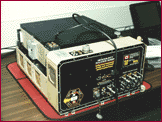



Objectives
The objective of this experiment was to ensure that the Microgravity Isolation Mount (MIM) provides an isolated microgravity condition (free from acceleration disturbances) for conducting experiments.
Shuttle-Mir Missions Approach Results Earth Benefits Publications Principal Investigators![]()
NASA-2 - NASA-7
The MIM hardware was located in the Priroda module of the Mir Space Station. MIM was used as an acceleration isolation platform. Experiment hardware was mounted to the MIM flotor platform which provided an isolation frequency range of 0.1 to 50 Hz. Acceleration data was recorded and stored on optical disks for post-mission analysis.
The MIM experiment supported the Microgravity Isolation Mount (MIM), Queen's University Experiment Liquid Diffusion (QUELD), Liquid Metal Diffusion (LMD), Technical Evaluation of MIM #1 and #2 (TEM #1 and #2), and Canadian Protein Crystallization Experiment (CAPE) experiments. This included 155 processed QUELD samples, 2 series of TEM experiments, 4 LMD experiments of 96 hours of duration, and 30 days CAPE operations for a total of over 1200 hours of operations.
MIM was designed to isolate microgravity science experiments that are potentially sensitive to small changes in acceleration. The real benefit of MIM comes through the experiments that used the MIM hardware. Improved results for these experiments ultimately lead to advances in material processing.
None available at this time.
Bjarni Tryggvason, Ph.D.
Canadian Space Agency (CSA)
![]()
|
|
Curator:
Julie Oliveaux
Responsible NASA Official: John Uri |
Page last updated: 07/16/1999
.gif)